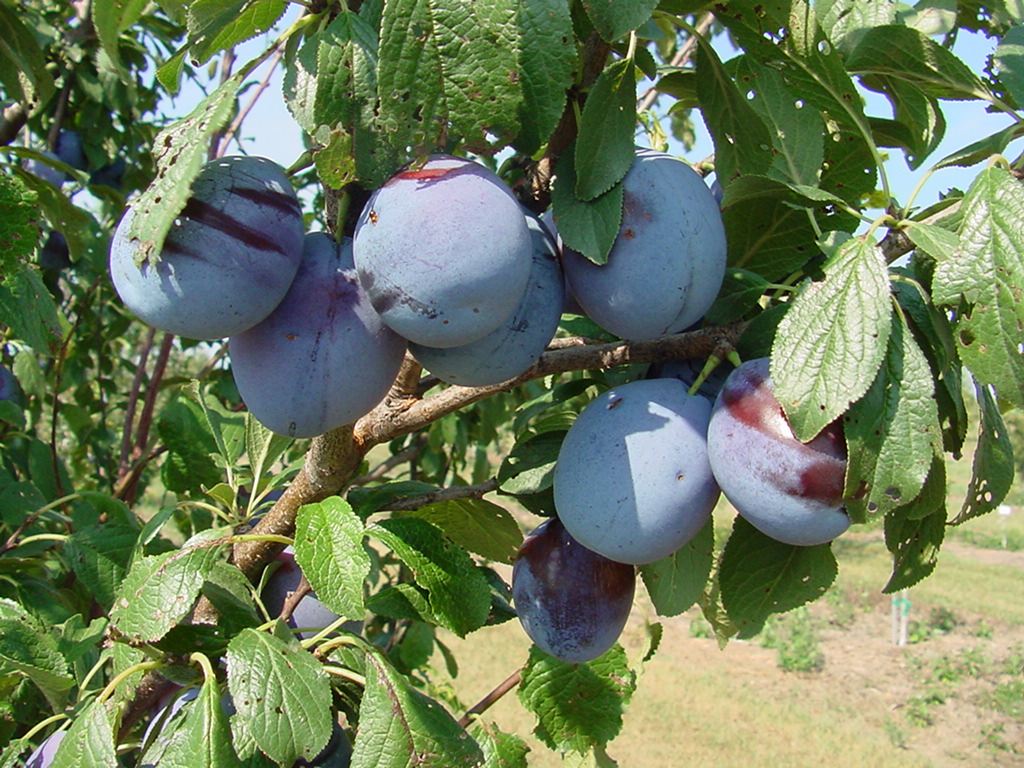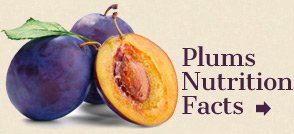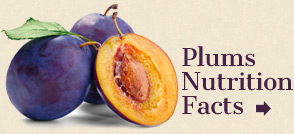 European plumTypes of Plums
European plumTypes of Plums
For most people buying plums in the marketplace or at farm markets, there are two major types of plums, European plums and Japanese plums.
The most common European plums (scientific name Prunus domestica L.) are elongated, blue types, but other colors are available as well. In the USA, European plums are eaten fresh, as fresh slices in salads and desserts, and processed as puree for baby food, baking, dried fruit, and fermented as alcoholic beverages, depending on the varieties.
Japanese plums (scientific name Prunus salicina Lindl. and hybrids) are primarily used as fresh market plums. Japanese plums range from round to heart shaped, and are a range of colors. Japanese plums are generally not suitable for drying as they do not contain sufficient sugar (must be at least 15%) and skin thickness to make a satisfactory prune.
These two general types, European and Japanese plum, plus several other plum types, can be organized by flower arrangement into Old World, and New World categories:
Old World plums have clusters of 1-3 flowers
P. domestica (European plums) This group is native to western Asia, in the Caucasus mountains adjacent to the Caspian Sea. They were brought to North America by colonists. Fruit in this group are generally elongated, blue types are most common in the marketplace, but other colors are available as well. In the USA, P. domestica is eaten fresh, as fruit slices and processed as puree for baking, dried fruit, alcoholic beverages, depending on the varieties.
Japanese PlumP. salicina Lindl. (called Chinese or Japanese plums) and hybrids. Native to China, brought to Japan, and then to the rest of the world. Japanese plums are fresh market plums, often larger than European plums. Japanese plums range from round to heart shaped, and are a range of colors. Japanese plums are generally not suitable for drying. Synonyms: Prunus triflora or Prunus thibetica.
P. insititia (damson, bullace, mirabelle, and St. Julien) Damsons are oval, with medium to dark blue skin and yellow-green flesh and are commonly used for jams and alcoholic beverages. Bullaces are round, yellow, green, blue or purple, smaller than damsons. Mirabelle plums are small, oval, yellow to maroon skin with green to amber fine-textured flesh, depending on the variety. The soft and sweet mirabelle are used in jams, pies, and fermented into wine or further distilled into brandy. In some cultures, mirabelles are eaten while they are sour and hard. St. Julien is used primarily as a dwarfing rootstock for plums and peaches.
P. cerasifera (cherry plum) Prunus cerasifera is a species of plum known by the common names cherry plum and myrobalan plum. It is native to Europe and Asia. Cultivated cherry plums can have fruits, foliage, and flowers in any of several colors. Some varieties have sweet fruits that can be eaten fresh, while others are sour and better for making jam. Myrobalan is an important plum rootstock.
The following are less commercially important old world plums, some ornamental types.Japanese Plum
P. mume Related to plum and apricots, and resembles the latter, grown in China, Japan, and Korea.
P. japonica (Korean cherry, flowering almond or Oriental bush cherry. Ornamental shrub species
P. cocomilia (Italian plum, not the same as Italian prune)
P. consociiflora (Chinese wild peach)
P. simonii (apricot plum)
P. spinosa (blackthorn or sloe) used for hedges
New World plums have clusters of 3-5 flowers
P. americana (American plum) – small fruited hardy plums, a few minor commercial varieties grown for fresh market.
P. alleghaniensis (Allegheny plum)
P. angustifolia (Chickasaw plum)
P. maritima (beach plum)
P. mexicana (Mexican plum)
P. nigra (Canada plum, Black plum)
P. × orthosepala (P. americana × P. angustifolia)
P. subcordata (Klamath, Oregon, or Sierra plum)
P. hortulana (Wild goose plum)
Hybrid plums
Crosses of Japanese plums with native American plums has resulted in many varieties exhibiting a range of colors, sizes, flavors and winter hardiness.
Another broad category of hybrids are interspecific crosses of plums with apricots. These go by various names such as plumcots, apriplums, apriums or pluots. Plumcot is a term coined by Luther Burbank and pluot is a registered trademark of Zaigers Genetics, a Modesto, CA company. Aprium, a registered trademark of Zaigers Genetics, refers to plum/apricot combinations that resemble the apricot component more than the plum.
Further details on important old world plum types
European Plum Cultivars
These are can be classified loosely on fruit color and/or size, and use (processed or fresh).
Dried plums / prunes – Elongated to oval, dark blue or purple with high sugar content and somewhat fibrous flesh suitable for processing as dried fruit. Prune plums often have a prominent waxy blush, many are freestone cultivars, eaten fresh, processed, or dried.
Yellow - Large, yellow, oval plums primarily used for fresh consumption and less commonly for canning. Generally soft textured, mild flavored
Gage – Small, round, green, yellow to pink/purple plums used for canning and fresh market.
Lombard - Large, oval, red or pink plums, used for fresh market in western Europe, once widely grown variety in the USA in the early 1990s.
Japanese Plum Cultivars
Can be classified according to shape (round, pointed, heart shaped), skin and flesh color.
Yellow skinned types including Ohishi Washi , Obilinaya, and Shiro
Red skinned types include Early Magic, Ozark Premier, Burbank, Fortune and many others.
Blue/purple skinned types include Methley, Black Ice, and Angeleno.




